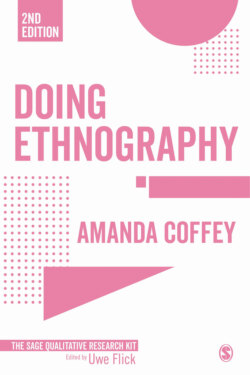Читать книгу Doing Ethnography - Amanda Coffey - Страница 8
На сайте Литреса книга снята с продажи.
About this book
ОглавлениеUwe Flick
In the early as well as in the more recent development of qualitative research, ethnography has played a major role. Much of what we know about field relations, about openness and directedness towards a field and its members is known from research in ethnography. Although ethnography is closely linked to the method of participant observation, and was based on it or maybe has replaced it more recently, ethnography always included a variety of methods of data collection. Quite often we find combinations of observation, participation, more or less formal interviewing and the use of documents and other traces of events in ethnography. At the same time, not every relevant issue is accessible for ethnography, participation and observation. Sampling in this context is less focused on people to select for the research than on selecting fields or institutions, or more generally, sites for observation. Towards the end of the twentieth century, methodological discussions in ethnography more and more shifted from issues of data collection and finding a role in the field to questions of writing about and reporting from the field, the research and the experiences in it. Analyzing ethnographic data is often oriented towards searching for patterns of behaviours, interactions and practices.
In this book such key topics of doing ethnography are unfolded in some detail. Whereas the other books are more focused on verbal data, like interviews (Brinkmann and Kvale, 2018) or focus groups (Barbour, 2018), or concentrate on analyzing conversations (Rapley, 2018) or images (Banks, 2018), Doing Ethnography brings the pragmatics of field research into the scope of The SAGE Qualitative Research Kit. At the same time, it can be complemented by more detailed analysis of using these sources (from interviews to visual data) in the more general context of ethnography. The books on analyzing data (Gibbs, 2018), designs and quality in qualitative research (Flick, 2018a, 2018b) triangulation (Flick, 2018c) and grounded theory (Flick, 2018d) add some extra context to what is outlined here in some detail. Together these books and this one allow us to decide when to use ethnography and observation and provide a methodological and theoretical basis for using this strategy in the field. The exemplary studies repeatedly used for illustration in this book are helpful for seeing ethnography not so much as a method but more as a strategy, and when it is appropriate to issues and fields under study.
